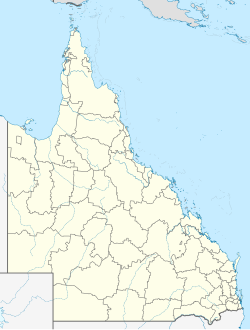History
Hawthorne started as a farming district in the 1860s, and was gradually subdivided as Brisbane grew. This was helped by the introduction of ferry and tram services.
In February 1885, the "Hawthorne Estate" was advertised for sale by Arthur Martin & Co. [6] The reverse of the advertisement included a sketch of the Hawthorne Estate from across the river. [7]
In October 1885, the "Galloway's Hill Estate" was advertised to be auctioned by Arthur Martin & Co. [8] A map shows the blocks, including river front land, in Wendell Street, Waldo Street, and adjoining land in Hawthorne Road. [9]
The "Oak Park Estate", made up of blocks on Orchard Street, Park Street and Oak Street, was first advertised for sale in September 1885. [10] A map advertising 33 allotments in the estate to be auctioned on 13 August 1887 shows the auctioneer was G.T. Bell & Co. [11] Due to inclement weather that sale was postponed to 20 August 1887. [12]
The "Bulimba Road Estate", made up of 200 blocks near the Hawthorne Estate, was advertised for sale in June 1887. [13] [14] A map advertising the estate shows the blocks near Bulimba Road (now Hawthorne Road) for auction by Arthur Martin & Co. [15]
The "Bulimba Park Estate", comprising 78 allotments in the area that is now Mullens Street, Barton Road and adjoining lots on Hawthorne Road and Riding Road, was advertised for sale in November 1887. [16] A map of the estate notes the seller of the land as the Metropolitan Freehold Land & Building Company Limited, and the auctioneer as G.T. Bell. [17]
In November 1888, the "Circular Quay Estate", made up of 40 allotments, including six riverfront blocks, within five minutes' walk to the Bulimba steam ferry, was advertised to be auctioned by John Macnamara & Co. [18] A map shows the lots in the area of land currently bordered by Leura Avenue. [19]
On 14 November 1914, a Church of Church was erected in a day. A Bible school had been previously established in 1912 by Mr R. Halgh, using a hall near the Hawthorne ferry wharf. In 1970, the building was raised and renovated with the addition of a ground hall for use as a hall. [20]
Lourdes Hill College was established in February 1916 by the Sisters of the Good Samaritan. [21] It was officially dedicated on Sunday 7 May 1916 by Roman Catholic Archbishop of Brisbane, James Duhig. [22]
In September 1935, "Barton Lodge Estate", comprising six blocks on Barton Road and Gordon Street, were advertised to be auctioned by Cameron Bros. [23] A map advertising the auction shows three of the blocks with river frontage and all within walking distance of the Hawthorne ferry and the Balmoral tram terminus. [24]
Demographics
In the 2011 census, Hawthorne had a population of 4,775 people, of whom 50.5% were female and 49.5% were male. The median age of the population was 33; four years younger than the Australian median. 71.3% of people living in Hawthorne were born in Australia, compared to the national average of 69.8%. The other most common countries of birth were England (5.1%), New Zealand (3.9%), Scotland (0.9%), the United States (0.9%), and South Africa (0.8%). 88% of people only spoke English at home, while the next most commonly spoken languages were Spanish (0.8%), Greek (0.7%), French (0.6%), Japanese (0.4%), and Italian (0.4%). [25]
In the 2016 census, Hawthorne had a population of 4,989 people. [26]
In the 2021 census, Hawthorne had a population of 5,090 people. [1]



